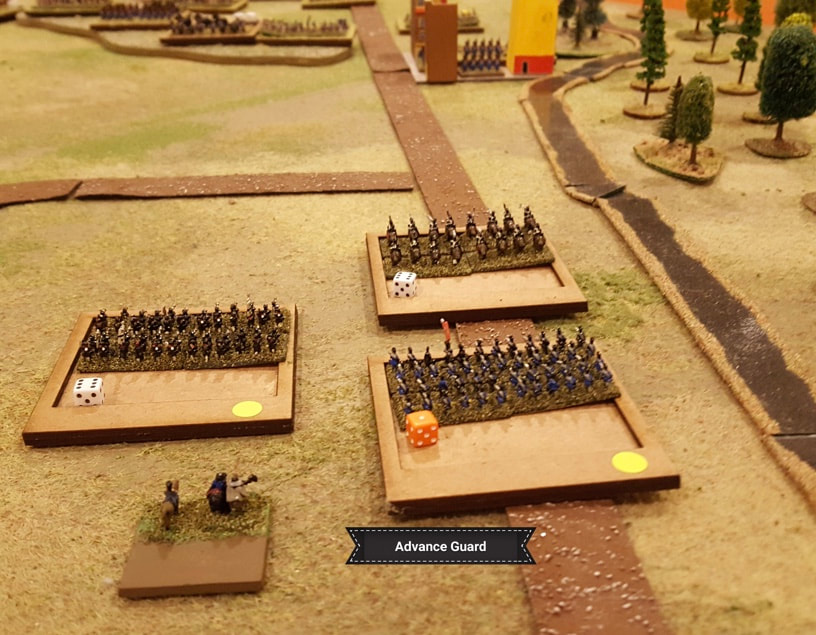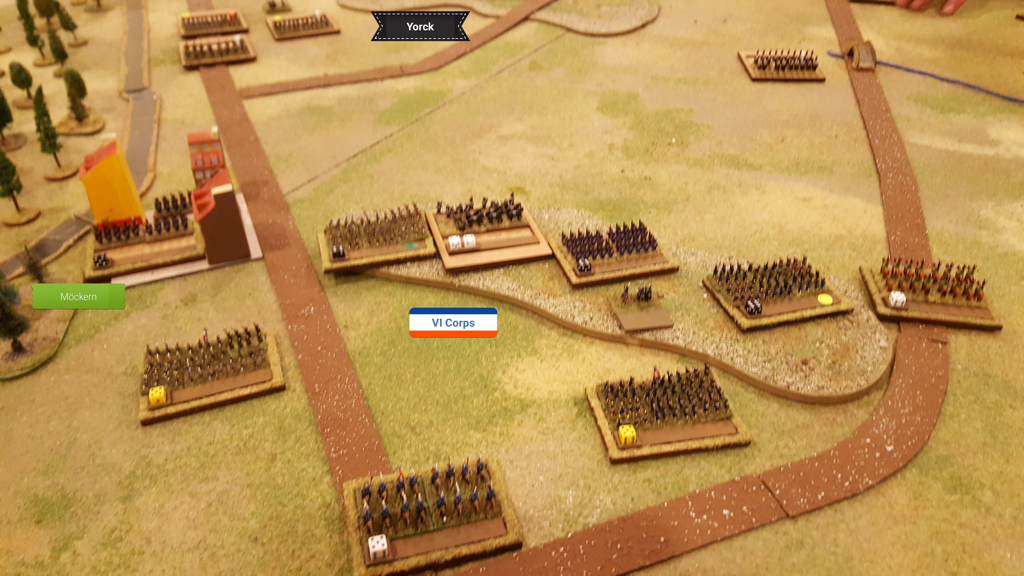|
I had a gaming-heavy weekend last week, starting with the annual trip to Warfare in Reading. This continues to be my favourite show on the circuit. The stalls seemed pretty busy and I hope the traders made enough to come back next year. I picked up some 20mm AFVs and scenery bits for Battlegroup, a copy of the Lardies’ What a Tanker! rules and a lot more MDF 6mm Napoleonics from Commission Figures. I bought my first Commission figures at Warfare 2017 and am really impressed with them. At playing distance they are indistinguishable from metals and at £2 for 96 infantry, they are fantastic value. My friend Keith came up to Warfare from Devon and stayed overnight. We played a game of Blücher when we got back from the show. I’d written a scenario for Möckern, the northern battle on the first day of the battle of Leipzig, 16 October 1813. I had first planned to use 15mm figures but realised I had enough 6mm figures to play it at that scale, provided I paint up a couple more French units. I wanted to see how 6mm units affected the feel of the game so after a couple of evenings with the paintbrush I had the full order of battle. The two extra units were of the French Naval Artillery, who wore blue greatcoats with red epaulettes and were mistaken by their opponents for sailors of the Guard. The scenario is on the Napoleonic scenarios page here. The background to the battle is as follows. On 16 October 1813 Napoleon’s army stood at bay in the city of Leipzig, surrounded by advancing Allied armies. Napoleon’s plan for the day was to strip his northern flank to reinforce an attack by his troops facing Schwarzenberg’s Army of Bohemia to the South. He ordered Marmont to take his VI Corps out of its entrenchments north of Leipzig and set off southward. However, after Marmont had abandoned his position and was approaching Leipzig, Blücher’s Army of Silesia appeared from the North. On his own authority Marmont halted his retreat and took up a defensive position before the city, with his left flank resting on the village of Möckern. Thanks to Blücher’s aggressive advance, Napoleon would now have fewer troops at his disposal against Schwarzenberg. Moreover, his northern flank was significantly at risk from Blücher’s advancing army. Fortunately for Napoleon, Blücher did not take full advantage of his opportunity on 16 October. Blücher believed that significant French forces were approaching from the North East and he feared an assault on his left flank. He spent most of the battle on that side of the field and he held back much of his army in anticipation of an enemy attack that didn’t happen. The burden of the day’s fighting consequently fell most heavily on Yorck’s First Corps. The scenario gives the Allies only those forces that were committed early enough to affect the outcome. By doing this, what would otherwise be a walkover becomes a tense contest. As the Allied commander, Keith began the game with an attack by Prussian Grenadiers on the village of Möckern, which was held by a Naval artillery brigade. The Grenadiers were his best troops but the odds were still against them. Even so they kicked my troops straight out of the village. My reserve brigade pushed the Prussians out in my next turn but Keith’s second brigade was on hand to bundle out my troops again. By this time his main body had come up and assaulted my centre. Now that more of my units had been pinned by this advance, I had no more reserves to retake Möckern. Before long I reached my morale limit and the day was lost. The game followed the events of the historical battle pretty well. I might have hoped to hang on to Möckern for a bit longer at the outset, as the dice were firmly in my favour. But it was fitting that Prussian Grenadiers should roll the best possible result. I particularly like the way Blücher handles fighting for built up areas. Victory goes to the side with the last formed reserve. If you want to hang on to a town it is vital to have fresh troops in support within a Charge move away. The new occupants will be easier to evict if you don’t give them the time to form town order. In hindsight I made two important mistakes. One was to open fire with my artillery at too long a range and against the wrong targets, thereby wasting shots. The other was to advance cavalry to engage the enemy near his baseline. Thinking about it after the game, I should have held all my force back to wait for the enemy assault. A cavalry unit is if anything more dangerous when uncommitted. I was already outnumbered and there was no merit in reducing my strength still further. How did it feel using 6mm figures? Very satisfying. We liked the impression of distance and the look of the table was more convincing than with my 8-man-per-brigade 20mm armies. I had to make do with some unfinished movement trays that weren’t quite the right shape but I was still happy. I am now waiting for pay day to order a new batch of proper-sized trays.
I love this hobby!
0 Comments
Leave a Reply. |
Archives
November 2023
Categories
All
|





 RSS Feed
RSS Feed